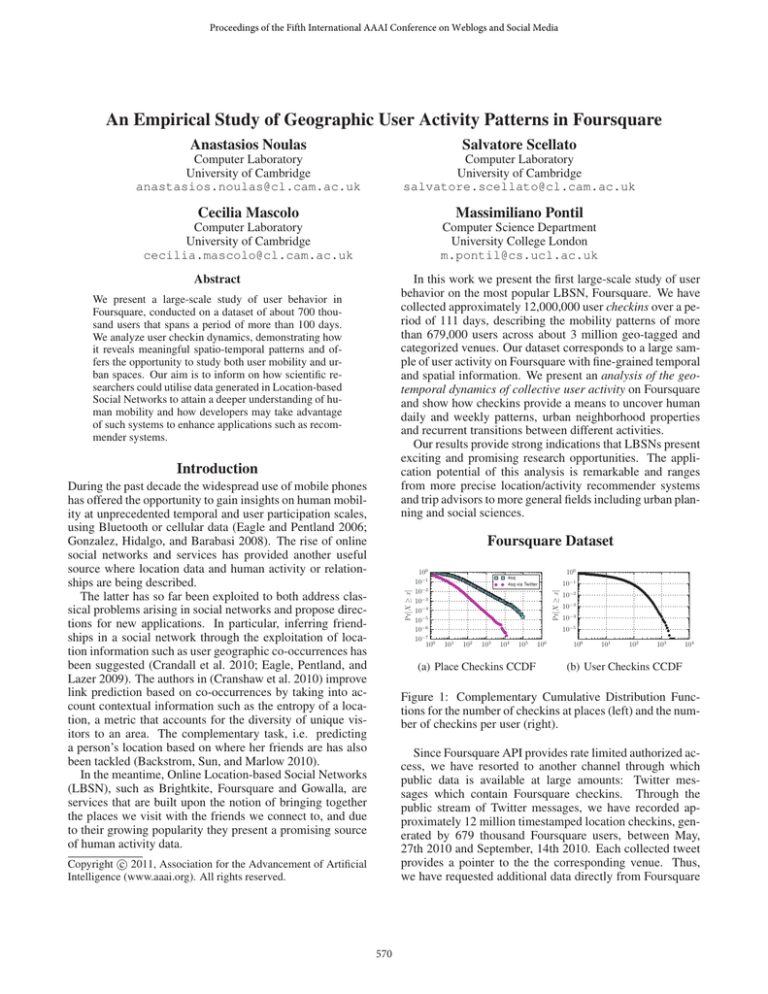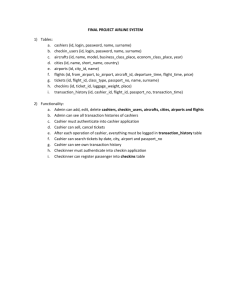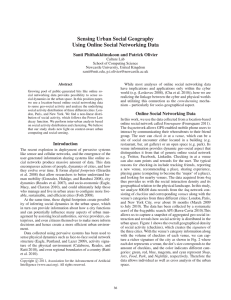
Proceedings of the Fifth International AAAI Conference on Weblogs and Social Media
An Empirical Study of Geographic User Activity Patterns in Foursquare
Anastasios Noulas
Salvatore Scellato
Computer Laboratory
University of Cambridge
anastasios.noulas@cl.cam.ac.uk
Computer Laboratory
University of Cambridge
salvatore.scellato@cl.cam.ac.uk
Cecilia Mascolo
Massimiliano Pontil
Computer Laboratory
University of Cambridge
cecilia.mascolo@cl.cam.ac.uk
Computer Science Department
University College London
m.pontil@cs.ucl.ac.uk
In this work we present the first large-scale study of user
behavior on the most popular LBSN, Foursquare. We have
collected approximately 12,000,000 user checkins over a period of 111 days, describing the mobility patterns of more
than 679,000 users across about 3 million geo-tagged and
categorized venues. Our dataset corresponds to a large sample of user activity on Foursquare with fine-grained temporal
and spatial information. We present an analysis of the geotemporal dynamics of collective user activity on Foursquare
and show how checkins provide a means to uncover human
daily and weekly patterns, urban neighborhood properties
and recurrent transitions between different activities.
Our results provide strong indications that LBSNs present
exciting and promising research opportunities. The application potential of this analysis is remarkable and ranges
from more precise location/activity recommender systems
and trip advisors to more general fields including urban planning and social sciences.
Abstract
We present a large-scale study of user behavior in
Foursquare, conducted on a dataset of about 700 thousand users that spans a period of more than 100 days.
We analyze user checkin dynamics, demonstrating how
it reveals meaningful spatio-temporal patterns and offers the opportunity to study both user mobility and urban spaces. Our aim is to inform on how scientific researchers could utilise data generated in Location-based
Social Networks to attain a deeper understanding of human mobility and how developers may take advantage
of such systems to enhance applications such as recommender systems.
Introduction
During the past decade the widespread use of mobile phones
has offered the opportunity to gain insights on human mobility at unprecedented temporal and user participation scales,
using Bluetooth or cellular data (Eagle and Pentland 2006;
Gonzalez, Hidalgo, and Barabasi 2008). The rise of online
social networks and services has provided another useful
source where location data and human activity or relationships are being described.
The latter has so far been exploited to both address classical problems arising in social networks and propose directions for new applications. In particular, inferring friendships in a social network through the exploitation of location information such as user geographic co-occurrences has
been suggested (Crandall et al. 2010; Eagle, Pentland, and
Lazer 2009). The authors in (Cranshaw et al. 2010) improve
link prediction based on co-occurrences by taking into account contextual information such as the entropy of a location, a metric that accounts for the diversity of unique visitors to an area. The complementary task, i.e. predicting
a person’s location based on where her friends are has also
been tackled (Backstrom, Sun, and Marlow 2010).
In the meantime, Online Location-based Social Networks
(LBSN), such as Brightkite, Foursquare and Gowalla, are
services that are built upon the notion of bringing together
the places we visit with the friends we connect to, and due
to their growing popularity they present a promising source
of human activity data.
100
10−1
10−2
10−3
10−4
10−5
10−6
10−7 0
10
100
4sq
4sq via Twitter
10−1
Pr[X ≥ x]
Pr[X ≥ x]
Foursquare Dataset
10−2
10−3
10−4
10−5
101
102
103
104
105
(a) Place Checkins CCDF
106
100
101
102
103
104
(b) User Checkins CCDF
Figure 1: Complementary Cumulative Distribution Functions for the number of checkins at places (left) and the number of checkins per user (right).
Since Foursquare API provides rate limited authorized access, we have resorted to another channel through which
public data is available at large amounts: Twitter messages which contain Foursquare checkins. Through the
public stream of Twitter messages, we have recorded approximately 12 million timestamped location checkins, generated by 679 thousand Foursquare users, between May,
27th 2010 and September, 14th 2010. Each collected tweet
provides a pointer to the the corresponding venue. Thus,
we have requested additional data directly from Foursquare
c 2011, Association for the Advancement of Artificial
Copyright Intelligence (www.aaai.org). All rights reserved.
570
and acquired the following information about a venue: geographic coordinates, category, total number of checkins,
unique number of visitors and address. As a result, we have
acquired a large set with fine-grained spatial and temporal
data. While this methodology allows us to acquire data only
about the subset of Foursquare users who have selected to
share their checkins publicly via Twitter, our sample represents approximately 20% to 25% of the entire Foursquare
user base which amounted in total 3 million users as of
September 2010 (Techcrunch 2010).
As an introductory step to our analysis, we present here
some comments about how users share information about
their locations. The number of checkins is an indicator
of popularity for places among users. In Figure 1(a) we
report the complementary cumulative distribution function
(CCDF) of the number of observed checkins at each location. We present two cases: the number of checkins per location in our dataset, acquired via Twitter over 111 days, and
the number of total checkins reported on Foursquare (since
its inception) for each venue. While our sample contains
only a subset of checkins at each venue, the two distributions exhibit the same trend, with heavy tail and power-law
behavior. Only a few places feature a large number of checkins, while a higher number of places have only few checkins.
For instance, a central train station will have higher levels of
user activity compared to a small park at the outskirts of a
city. In Figure 1(b) we show the CCDF of the number of
checkins per user. Again, we have a heavy tail in the distribution, denoting how user participation can vary significantly. About 20% of users have just one checkin, with 40%
above 10, whereas there is a set of approximately 70,000
active users (around 10%) that has more than 100 checkins. The reasons behind this heterogeneity in user behaviour
could be many, ranging from cognitive factors (e.g., if a user
forgets checkin at a place), to social ones (e.g., sharing location with friends), as checkins are voluntary and not automatic in Foursquare. Privacy is also a fundamental aspect to
consider here.
Home (bottom)
Corp. / Office
Cafe
Highway
Train Station
Mall
Bar
Other - Buildings
Supermarket
Train
250000
#Checkins
200000
150000
100000
50000
0
6am
8am
10am
12pm
2pm
4pm
6pm
8pm
10pm
12pm
2am
4am
Time
(a) Weekdays
Home (bottom)
Cafe
Mall
Bar
Highway
Supermarket
Dpt Store
Train Station
American
Hotel
120000
100000
#Checkins
80000
60000
40000
20000
0
6am
8am
10am
12pm
2pm
4pm
6pm
8pm
10pm
12pm
2am
4am
Time
(b) Weekend
Figure 2: Stacked plot of the 10 most popular categories over
weekdays and weekends. Popularity decreases bottom-up.
between 12pm and 10pm. Another difference to note between the two is that category Corporate/Office disappears
from the top set of user activities and is substituted by leisure
related activities such as American (Food) and Hotel, while
categories such as Bar and Mall also show increased preference rates among users. In both cases, however, checkins
at the Home category show a continuous rise throughout the
day, with a steeper increase at 6pm during weekdays. While
those findings are in line with what may be expected by a human observer, they also demonstrate that these data could be
used to record and measure how human communities commit to different tasks over time and benefit research in social
sciences or the development of applications for smartphone
users.
Spatio-Temporal Patterns of User Activity
We now present an analysis of the dynamics of Foursquare
user activity.
Our findings suggest that activity in
Foursquare varies within the course of a day and of a week,
with meaningful patterns closely related to human activity
from a temporal and spatial point of view. Finally, we describe how checkins constitute spatio-temporal traces that
can help to investigate user transitions from one place or activity to the next.
Geo-Temporal Rhythms In Figures 2(a) and 2(b) we plot
the number of checkins across the ten most popular categories observed during weekdays and weekends. The two
curves present considerably different patterns. At weekdays
activity presents three peaks: in the morning when people
go to work, at lunchtime and between 6pm and 8pm when
they commute, return home or go to malls and bars. On
the other hand, during weekends user activity presents a
smoother evolution course, reaching a long lasting plateau
Checkin Dynamics We now investigate how user checkins take place over time and space. In Figure 3(a) we plot the
CCDF of inter-checkin times, where an inter-checkin time
is defined as the temporal interval between two consecutive
checkins. More than 10% of checkins occur within 10 minutes, while this fraction rises up to 30% within 100 minutes
and a large portion, almost 20%, is longer than 2000 minutes
(approximately 33 hours). This represents a major differ-
571
−1
10−2
10−3
10−4
100
101 102 103 104 105 106
Inter-checkin Times in minutes
(a) Inter-Checkin Times CCDF
IC Time [mins]
10
1200
100
Pr[X ≤ x]
Pr[X ≤ x]
100
10−1
10−2
10−3
10−2 10−1 100 101 102 103 104
Inter-checkin Distances in km
1000
800
600
400
200
(b) Inter-Checkin Distances CCDF
0
0
10 20 30 40 50 60 70 80
IC Distance [km]
(c) Time Overs Distance
Figure 3: Temporal and spatial intervals of consecutive user checkins (a),(b) and median inter-checkin time over distance (c).
ence with previous studies (Zheng et al. 2008), where user
location was periodically sampled through GPS. As a consequence, the frequency at which users report their locations
in the system should be taken into account in every specific
usage scenario, either for scientific research or for application design. For example, two temporally close checkins
of the same user could signal an important correlation between two locations, but as this temporal distance increases
we could express higher confidence that the two checkins
are not strictly consequential.
Similarly, in Figure 3(b) we plot the CCDF of intercheckin distances. It exhibits a comparable power law behaviour: 20% of checkins occur within a distance of 1 km,
a significant proportion of 60% between 1 and 10 km, 20%
of checkins take place at distances over 10 km and a small
portion of these, around 5%, extend to distances beyond 100
km. However, it is likely that longer inter-checking distances
are correlated with longer inter-checkin times, since physical motion between distant locations inevitably requires
longer periods of time.
In fact, we demonstrate how inter-checkin times and intercheckin distances are correlated in Figure 3(c), where we
plot the median inter-checkin time as a function of the intercheckin distance. For each pair of subsequent checkins we
have rounded the distance between the locations involved
with precision of plus/minus 500 metres and then measured
the median value of the distribution of checkins that took
place across a given distance. Inter-checkin times observed
within 500 metres have a median value of approximately
one hour. The trend of observing a larger temporal interval
as users cover larger distances increases fast for distances
within a range of 6 kilometres, whereas above this threshold the rate of increase slows significantly and stabilizes at
relatively large distances of 60 to 70 kilometres.
cij
k∈C cik
Category
Pt10
Pt∗
Train
Terminal
Gate
Moroccan
Train Station
Rental Car
Plane / In-flight
Tram
Cineplex
Plane
Bridge
Lab
Surf Spot
Trade/Tech School
Emergency Room
Hotel Bar
Engineering
Movie Theater
Other - Travel
Taxi
Train Station
Airport
Airport
Theme Park
Train
Airport
Airport
Airport
Mall
Airport
Highway / Traffic
University
Beach
Other - Buildings
Hospital
Hotel
University
Mall
Highway / Traffic
Highway / Traffic
0.48
0.46
0.45
0.39
0.38
0.36
0.33
0.33
0.30
0.28
0.28
0.26
0.25
0.25
0.25
0.24
0.24
0.24
0.23
0.23
0.30
0.17
0.22
0.06
0.22
0.18
0.19
0.19
0.08
0.15
0.10
0.09
0.06
0.07
0.08
0.07
0.07
0.06
0.11
0.09
Table 1: Top-20 Activity Transition Probabilities for Pt10 .
where C denotes the set of all categories and cij the number of checkin transitions from a place in category i to one
in category j. We let Pt10 be the transition probability between consecutive categories conditioned on the transition
time being less than 10 minutes. We impose this threshold
in order to apply a mobility bias to the transition data. In
Table 1 the top twenty transition probability values between
categories are reported. As a comparison we list the values of Pt∗ , which has no temporal threshold imposed. These
probabilities could be interpreted as weights of transitions
on an activity graph G, where nodes are the 288 place categories and edges exist if transitions have occurred from one
category to another. Comparing Pt10 and Pt∗ , we notice that
probability Pt∗ is much lower than Pt10 : when calculating
transitions without considering the time between subsequent
checkins then the activity transition graph becomes noisy, as
users checkin voluntarily and certain transitions may not be
reported. The intriguing aspect of the probabilities calculated in Table 1 is that the LBSN user generated data can
provide valuable insights on how activities of mobile users
success each other. Moreover, those activity networks could
Activity Transitions An important aspect to consider with
respect to human behaviour, is how different activities succeed each other. The question we ask is: If person X is
engaged in activity Y (i.e., visiting a place belonging to category Y ), which activity will follow next? In particular, we
calculate the transition probability Pt (i, j) from category i
to category j as:
Pt (i, j) = Category
(1)
572
Category
Category
Dist(km)
checkins
Category
Category
Dist(km)
checkins
Train Station
Train Station
Light Rail
Train Station
Train Station
Mall
Monument / Landmark
Mall
Corporate / Office
Playground
Train Station
Technology
Mall
Monument / Landmark
Convention Center
Movie Theater
Park
Apparel
Corporate / Office
Karaoke
3.5
0.16
0.02
2.0
0.57
0.01
4.34
0.50
0.60
0.50
231
187
122
101
97
73
67
64
61
59
Airport
Airport
Airport
Monument / Landmark
Parks & Outdoor
Gym
Coworking Space
Airport
Train Station
Gym
Gate
Airport
Airport
Train Station
Theme Park
Hospital
Coffee Shop
Gate
Bus Station
Corporate / Office
543.7
1177
1092
267
0.37
2.18
0.04
3973.3
329
2.09
147
107
71
65
62
47
47
45
45
44
Table 2: Top Place Transitions for inter-checkin times of 0-10 minute (left) and 100-500 (right) minute intervals.
be calculated for different temporal periods (i.e. morning,
night etc.) or geographic regions (Europe, US, Asia etc.).
While mobile applications that target content to mobile users
could be profoundly benefited from such analysis, we now
demonstrate how the possibility for location-based marketing or other strategies also rises.
opportunistic gateways that users can exploit at will, poses
challenges at the analysis and interpretation of the data. As
it has been shown, imposing spatio-temporal thresholds can
unfold different classes of place transitions or help in the
identification of sequential activity transitions.
Moreover, the analysis of the geo-temporal rhythms of
user checkins informs us on the general consensus of user
activity at a given time and place. A recommendation or advertising application could take this into account in order to
tune its content. The activity and place transitions previously
analyzed could also contribute to this direction.
In terms of future work we intend to study the development of prediction frameworks on user activity and mobility. Moreover, a problem not addressed in this paper, is how
users in LBSNs generate content, such as comments, tips
and tags. Topic modelling techniques could be used in order
to extract information through textual data overlaid on the
geo-social plane.
Place Transitions In Table 2 we present the top ten place
transitions in terms of checkin frequency for inter-checkin
times that fall in the 0 to 10 minute (left) and 100 to 500
minute intervals (right). To facilitate interpretation we show
the categories of those places, whereas the distance and the
number of checkins between the two locations are also reported. We can see that that transitions occurring at smaller
intervals concern places that are geographically proximate.
Such cases could include travels between train stations, leaving the mall to watch a movie or the office to attend a meeting nearby. Switching our view to the 100 to 500 minute
interval, the analysis reveals a new class of place/activity
transitions. While people fly from one city to another and
checkin at the corresponding airports, they unfold spatiotemporal connections of larger scales. The most frequent
location transition in this case is between San Francisco International Airport and Los Angeles International Airport
(LAX). The eighth transition with a distance of 3973.3 km
is that between LAX and JFK Airport in New York. Another observation is the fifth case that takes place within Disneyland at Anaheim, California. Despite occurring within a
small spatial interval, this may indicate an existence of a location where people stay for a long duration (for instance a
restaurant) and then move to a different place nearby. The
analysis of the place and activity networks in Foursquare
opens a new direction for research, since for the first time
global and regional transport networks can be uncovered,
while a deeper understanding of collective human activity
could also be acquired.
References
Backstrom, L.; Sun, E.; and Marlow, C. 2010. Find me if you can:
improving geographical prediction with social and spatial proximity. In Proceedings of WWW’10.
Crandall, D. J.; Backstrom, L.; Cosley, D.; Suri, S.; Huttenlocher,
D.; and Kleinberg, J. 2010. Inferring social ties from geographic
coincidences. Proceedings of the National Academy of Sciences
107(52):22436–22441.
Cranshaw, J.; Toch, E.; Hong, J.; Kittur, A.; and Sadeh, N. 2010.
Bridging the gap between physical location and online social networks. In Proceedings of Ubicomp ’10.
Eagle, N., and Pentland, A. 2006. Reality mining: sensing complex
social systems. Personal Ubiquitous Comput. 10(4):255–268.
Eagle, N.; Pentland, A.; and Lazer, D. 2009. Inferring social network structure using mobile phone data. Proceedings of the National Academy of Sciences 106(36):15274–15278.
Gonzalez, M. C.; Hidalgo, C. A.; and Barabasi, A. 2008.
Understanding individual human mobility patterns.
Nature
453(7196):779–782.
Techcrunch.
2010.
Foursquare now 3 million strong.
http://techcrunch.com/2010/08/29/foursquare-now-3-millionstrong/.
Zheng, Y.; Li, Q.; Chen, Y.; Xie, X.; and Ma, W.-Y. 2008. Understanding mobility based on gps data. In Proceedings of Ubicomp
’08.
Discussion and Future Work
LBSN data offers unprecedented opportunities. Never before have such large communities of individuals been able
to exchange data about their location and activities through
interfaces that augment the natural environment with new
types of data layers. The fact that mobile devices do not
act as continuously monitoring sensors, but instead represent
573





